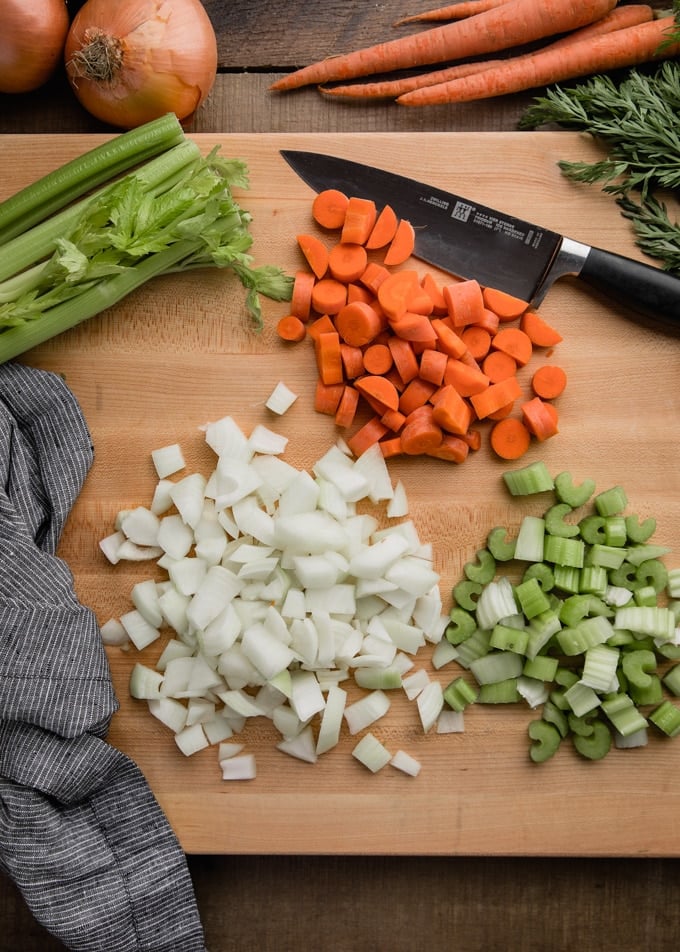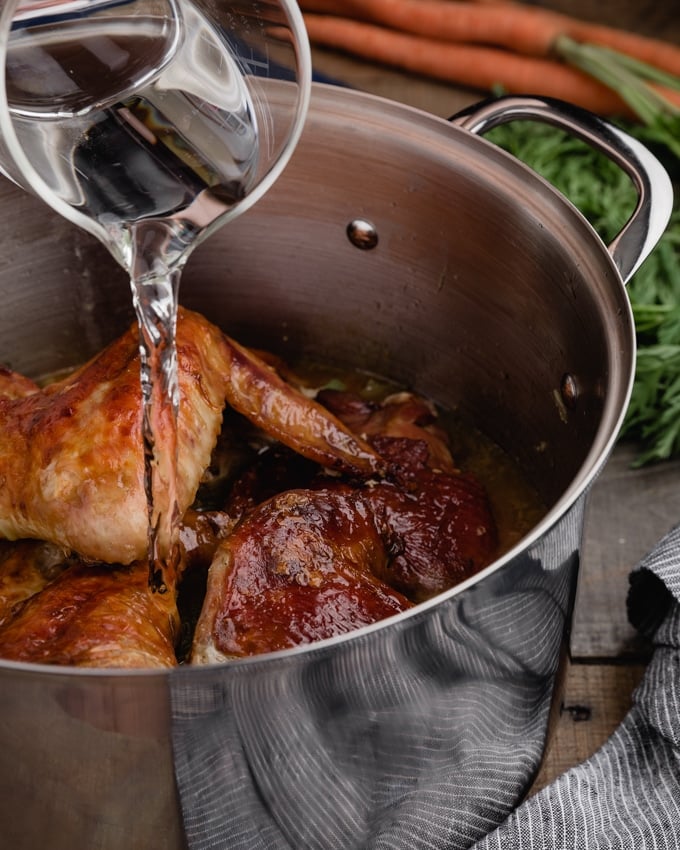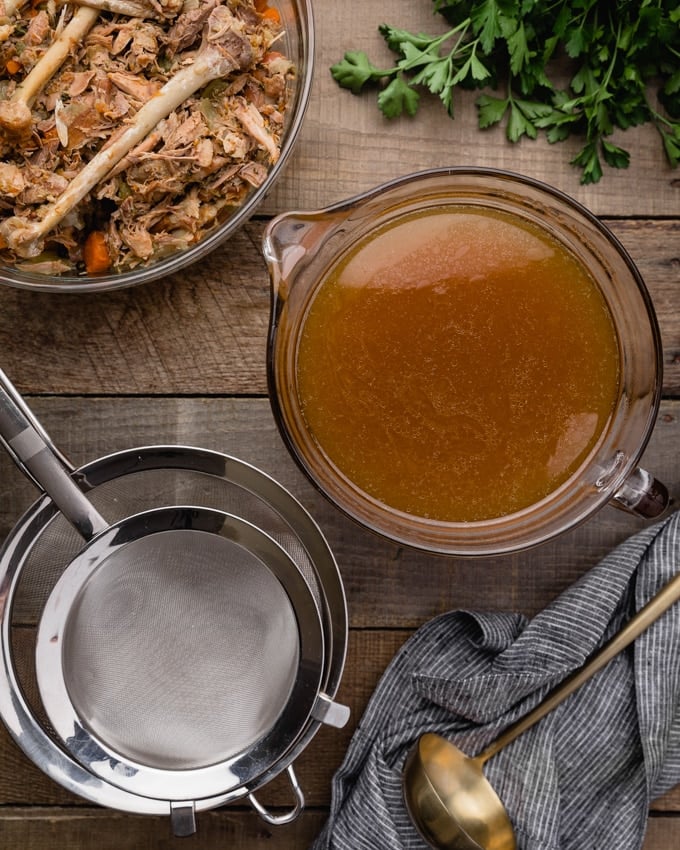Flavorful stock is an essential component to a showstopper Thanksgiving feast. This make-ahead turkey stock lets you a jump start on prep work in advance of the holiday. You’ll have a rich, aromatic stock for all of your stuffing, gravy, basting, and soup needs!
Making your own turkey stock from scratch is easier than you think and can add incredible depth of flavor to your soups stews gravies and more. While you may be used to just using store-bought broths and stocks, homemade allows you to control the ingredients and customize the flavors. In this article, I’ll walk you through the simple process of preparing turkey stock using the often overlooked but very flavorful turkey drumsticks.
Why Make Your Own Turkey Stock?
There are a few key reasons why making homemade turkey stock is worthwhile:
-
More flavor – Store-bought broths often have a diluted and generic taste. Homemade allows you to craft a rich, savory turkey flavor.
-
Control ingredients – By making it yourself you can avoid unwanted additives like preservatives MSG and excess sodium found in store-bought.
-
Use turkey parts – Drumsticks, necks, wings and bones that would normally be discarded can be repurposed into stock. Less waste!
-
Versatility – Turkey stock has a multitude of uses beyond just soups. It’s great for gravies, stews, pilafs, risottos and more.
-
Nutritious – Homemade stock is packed with collagen and minerals extracted from the bones during simmering. This nourishment gets passed on to any dish you use the stock in.
Equipment Needed
Making turkey stock is simple and doesn’t require any fancy kitchen tools. Here’s what you’ll need:
- Large stock pot or dutch oven
- Slotted spoon
- Fine mesh strainer
- Cheesecloth (optional)
- Quart or gallon freezer bags for storage
And the key ingredients:
- Turkey drumsticks
- Water
- Aromatics like onions, carrots, celery
- Herbs and spices
That’s it! Now let’s get to the fun part…
Step-By-Step Instructions
Follow these simple steps for deliciously flavored turkey stock using drumsticks:
1. Roast the Drumsticks
Roasting the drumsticks before simmering them will add richer, deeper flavors to your finished stock. Here’s how:
-
Preheat oven to 400°F. Rinse drumsticks and pat dry. Place in a roasting pan.
-
Generously season with salt, pepper and any other desired spices like thyme or rosemary.
-
Roast for 45 mins until browned, turning halfway through.
2. Sauté the Aromatics
While the drumsticks roast, prep your aromatics – onions, carrots, celery, garlic, etc.
-
In your stock pot, heat 1 Tbsp oil over medium heat.
-
Add chopped aromatics and cook for 5-7 minutes until starting to caramelize. Season with salt and pepper.
3. Simmer the Stock
Now it’s time to simmer everything together!
-
Transfer roasted drumsticks to the stock pot and add enough water to cover by 1-2 inches.
-
Bring to a boil then reduce heat to low. Simmer for 3-4 hours, uncovered.
-
For a richer stock, continue simmering partially covered for up to 8-10 hours.
4. Strain and Store
Once your stock has finished simmering, it’s time to strain out all the solids.
-
Pass the stock through a fine mesh strainer lined with cheesecloth.
-
Let cool slightly then transfer to quart size freezer bags or airtight containers.
-
Turkey stock keeps for up to one week refrigerated or up to three months frozen.
That’s all there is to it! You now have a batch of deeply savory homemade turkey stock using drumsticks ready for all your cooking needs.
Flavor Variations
One of the best parts of homemade stock is experimenting with unique flavor additions. Try adding any of the following to your stock pot:
- Fresh herbs – rosemary, thyme, sage, parsley
- Whole peppercorns
- Bay leaves
- Lemon zest
- Garlic cloves
- Ginger
- Tomato paste
- Mushrooms
- Leftover vegetable scraps
Mix and match different flavor combos until you find your favorite!
Uses for Turkey Stock
Homemade turkey stock is endlessly versatile in the kitchen. Here are just a few ideas for how to use that nourishing drumstick stock:
-
Turkey Noodle Soup – A classic! Use your stock as the base for hearty turkey noodle soup.
-
Gravy – For incredible scratch-made gravy, use turkey stock instead of water.
-
Risotto – Substitute turkey stock for part or all of the broth.
-
Braised Vegetables – Add big flavor to braised greens, beans or potatoes.
-
Stuffing – Moisten your stuffing with turkey stock.
-
Pilafs – Build depth of flavor in rice, quinoa or bulgur pilafs.
-
Turkey Pot Pie – Use as the base for a creamy turkey pot pie filling.
The possibilities are endless! Get creative and find new ways to incorporate your homemade turkey stock into meals.
Common Turkey Stock Questions
Here are answers to some common questions on preparing turkey stock:
How long does turkey stock last in the fridge or freezer?
- Fridge: 5-7 days
- Freezer: 3-6 months
Can I use a whole turkey carcass?
- Yes! Use the leftover bones/carcass from a roast turkey.
What turkey parts work best?
- Drumsticks, wings, necks and backbones have lots of collagen.
Is it necessary to roast the bones first?
- No, but roasting adds richer flavor through the Maillard reaction.
How do I remove the fat after making stock?
- Refrigerate and the fat will solidify on top, making it easy to remove.
What herbs and veggies should I use?
- Classic aromatics like onion, celery, carrot. Herbs like parsley, thyme, sage.
The Benefits of Homemade Stock
Whipping up turkey stock from scratch offers many perks beyond just better flavor. Here are some of the best benefits:
-
Saves money – Much cheaper than store-bought stock
-
Reduces waste – Uses turkey parts that would normally be discarded
-
Nutrition – Minerals like calcium, magnesium and potassium are extracted from the bones
-
Collagen – The simmering process draws out collagen from bones and connective tissues
-
Versatile – A flavor base for soups, stews, gravies, rice dishes and more
-
Control ingredients – Make it exactly how you want with natural ingredients

What You Need to Make Stock Without a Leftover Turkey
Raw turkey parts, such as wings and/or legs. You want to choose parts that have a high proportion of bones to meat for the richest stock.
If you don’t see turkey parts stocked in the case at your grocery store, ask the butcher. Oftentimes, they’ll have them in the back, or they can order them for you.
Should I use giblets if they’re available? You can add giblets with your turkey parts (I like to roast a neck, but it won’t take the full 90 minutes, so keep an eye on it). Be sure to pass on the liver; it will make your stock bitter.

Mirepoix: carrots, celery, onions, cut into a rough chop. No need to peel the carrots or de-string the celery, since the vegetables will be discarded.
Neutral-flavored oil, such as vegetable or canola.
Cool water. Starting a stock with hot or boiling water will result in a cloudy appearance. The water should come to a simmer with the other ingredients in the pot.
Seasonings: fresh parsley, thyme sprigs, bay leaf, whole peppercorns. If you’re using fresh bay, make sure it’s bay laurel. Fresh California bay leaves are much more strongly-flavored and can lend a medicinal taste to the stock. If you aren’t sure, use dried (which are almost always Turkish/bay laurel).
FAQ: Why no salt? As a rule, stock should not be salted. It is often added to other well-seasoned recipes and/or used in dishes where it’s reduced. Concentrating a salty flavor would be overpowering. Salt the recipe you’re adding stock to, not the stock itself.
In terms of equipment, you’ll need a large roasting pan, a stock pot, and a mesh strainer.

How to Make Turkey Stock Ahead of Thanksgiving: Step by Step
This turkey stock is an all-day affair, but much of the process after the prep work is hands off. I like to make it on a weekend, when I’m planning to spend a leisurely day at home. Here’s what you’ll need to do.
1. Roast the turkey parts. Fit the legs, wings, and neck into a single layer in a large roasting pan and pop it into a 425 degree F oven for about 90 minutes, until they’re deep golden brown on all sides. For best results, flip them halfway through.
Tip: If you’d like, you can shred some of the turkey off of the meatier pieces, like thighs or drums. The more meat that goes into the pot, the richer the stock will be, but there’s plenty here if the cook wants a treat!
2. When the turkey parts are almost finished roasting, roughly chop the vegetables and sweat them in a large stock pot with a few tablespoons of neutral oil (such as vegetable or canola).
The vegetables should be soft and just beginning to brown, but not caramelized. Remove from heat.

3. Deglaze the roasting pan. The flavorful bits on the bottom of the pan are pure gold for a flavorful stock. Don’t leave them behind!
Remove the turkey parts from the pan and place them in the stock pot with the sweated vegetables. Pour or skim off the fat in the pan. You can either discard this, or refrigerate it for when you make gravy.
Add 2 cups of water to the roasting pan and use a wooden spoon to scrape up all of those delicious, caramelized bits.
Add this flavorful liquid to the stock pot. Bonus: this process also gives you a jump start on cleaning your roasting pan!
Tip: If needed, you can put your roasting pan on the stove across two burners to heat up the liquid and help the deglazing process. Most of the time, the pan will be so hot from the oven that this isn’t necessary.

4. Pour the rest of the gallon of water into the stock pot. The water should cover the turkey parts by 1-2 inches. Bring the pot to a bare simmer over medium-low heat.
Tip: For the most beautiful stock, it’s important to not let the pot boil heavily. All you need is a steady, gentle simmer.
5. Skim the surface. As the liquid heats to its initial simmer, a white, foamy substance will collect on the top. Use a spoon to skim this off and discard.
6. Add the seasonings. Once the pot is skimmed, add the parsley, thyme, bay leaf and peppercorns to the pot. If your celery stalks had leaves, add them to the pot now.
Tip: I like to add my seasonings after the initial simmer instead of with the turkey parts and water. If the peppercorns are already in the pot when I’m skimming the foam, I have to be cognizant of not skimming them off as well.
7. Maintain a gentle simmer for 3 to 4 hours, until the stock is reduced and your kitchen smells heavenly.

I like to strain the meat, bones, and vegetables out of the stock in batches, letting as much liquid drain into the bowl as possible. To keep the stock from clouding, avoid the temptation to press down heavily on the vegetables.
For the most beautiful stock, I almost always double strain. I’ll send the first pour, where I’m separating out the bones, etc., through a standard stainless steel mesh strainer. Then, I’ll pour the liquid through a second, finer mesh strainer.
Alternatively, you can also line your strainer with cheesecloth. Do you have to do extra step? No. I just love a gorgeous, clear stock!
Tip: If you’d like, you can save the bones and use them to make a remouillage (“second stock”). This French technique of making stock from bones that have already been simmered once will yield a weaker stock than the first simmering. The remouillage can be used as a flavor boost in place of water in making your next batch of stock.

How To Make Turkey Stock – Turkey Broth Recipe
FAQ
What parts of a turkey are used for stock?
Can you use fried turkey bones for stock?
Why add vinegar to turkey stock?
What’s the difference between turkey broth and stock?
How do you cook a Turkey in a stockpot?
Transfer turkey parts and all fat and juices to a large stockpot. Cover turkey with water and place pot over high heat and bring water to a boil, then reduce heat, cover and simmer for as long as you can manage, even overnight. Add vegetables, bay leaves, thyme and pepper and continue to cook another hour, then strain stock into a clean container.
Should you add Turkey skin to stock?
Adding the turkey skin translates to tons of flavor. Skim the fat off the finished stock once it cools Omitting the skin will yield a stock with a thin, flat flavor. If you happen to have turkey bones that aren’t roasted, you can still follow this recipe. Your resulting stock will have a more neutral flavor and subtle color.
Can you make homemade Turkey stock from leftover turkey carcass?
While you can certainly make homemade turkey stock using a leftover turkey carcass (in fact, we encourage it), the problem inherent in doing so is that most people don’t have access to one until after the Thanksgiving holiday. For folks who want turkey stock to use day of, we’re delighted to report there’s another way.
How do you make homemade turkey broth?
In just a few steps, it’s simple to use every bit of the incredible flavor of roasted Thanksgiving turkey to make your homemade turkey broth. In an 8 Qt. stockpot, add the roasted turkey bones, apple cider vinegar, salt, and 16 cups of filtered water. Bring to a boil and then lower the heat to a simmer.
